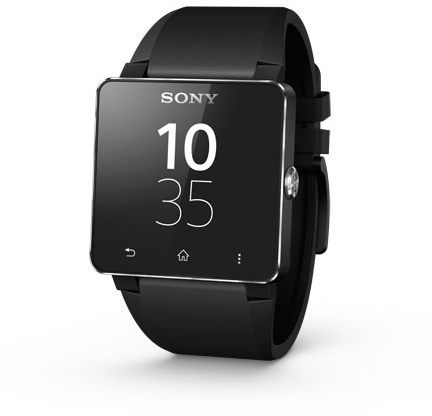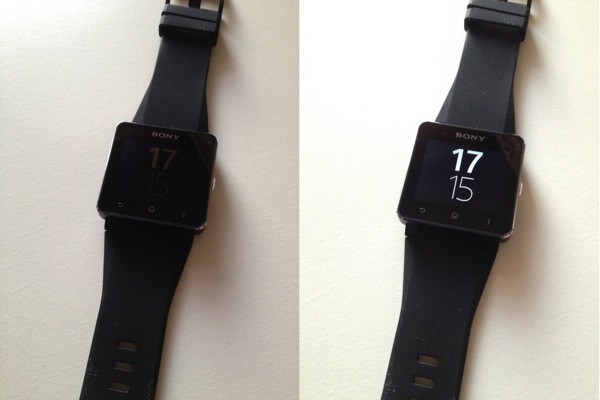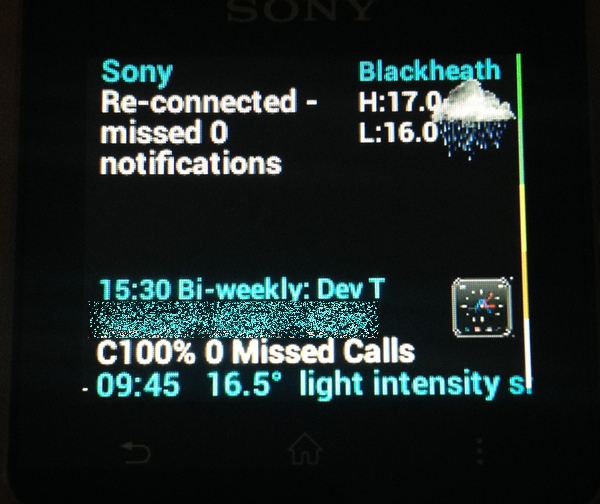I’ve been playing around with a Sony SmartWatch 2. Herein some thoughts on wearable devices and smart watches.

There’s been several iterations of the smart watch idea. The Verge smartwatch roundup covers the state of play; The Independent has an interesting article on why a Google smartwatch makes sense, and the Samsung Galaxy Gear advert demonstrates nicely the desire for these “James Bond” gadget watches over the years.
The Sony Smart Watch 2 is really nice hardware. It’s a decent size, but doesn’t feel too heavy or cumbersome on the wrist.

The “standby” watch face screen is easy to read. It also has a clever power saving feature where the display is turned off completely unless it detects you. I haven’t figured out how the detection works – presumably motion, touch, proximity or resistance. When the screen is on full it is bright and readable. The watch display is responsive, and swiping from screen to screen is fast and smooth.
The watch needs to be tethered to a phone, and this symbiotic relationship makes sense (up to a point). The watch on your wrist is more accessible than the phone in your pocket, so it’s easier and more natural to glance at the watch to see information. The challenge is figuring out what information you want to see, and getting that information displayed. For example, if you’re using a bluetooth headset and you receive an incoming call, caller ID is handy, along with the ability to accept or reject the call. SMS notifications are useful, but email notifications are too frequent and too verbose to be of much use.
Since the watch is strapped to your wrist and always on you, it allows nice features like warning you when you leave your phone behind. This works, and is useful. On the Sony watch, I achieved this using Augmented SmartWatch Pro; it vibrates the watch when the bluetooth connection to the phone is lost. It looks like similar functionality is on the Samsung Galaxy Gear.
You can’t install apps directly on the watch, you have to go via a management app on the phone. That makes sense, as the watch screen is not well-suited to browsing and buying from an app store. Sony claims more than 300 apps for the Smart Watch / Smart Watch 2. There’s a major flaw, however: you quickly realise that you want to customise the standby screen and watch faces, but those can’t currently be modified. So the alternate watch face apps are useless – you have to turn the watch display on, then navigate through the Sony watch face in order to see the alternate app. Or, you leave the app running and watch your battery drain in a matter of hours. It’s somewhat mitigated in that apps receiving notifications can light up the screen themselves. Apps like Augmented SmartWatch Pro go some way to offering useful alternate screens, even if they can’t be permanently displayed:

On the screen above: the weather forecast for my location, upcoming meetings, time, current temperature, phone battery status (graduated colour bar on the right) and watch battery status (left; non-existent).
Speaking of battery life: I’ve found it to be better than a phone, but still only lasting a few days (depending on usage). In a world where we get used to plugging in our phone every night that wouldn’t be so bad, except that the cover over the micro-USB charging slot is fiddly, and plugging in multiple devices quickly gets boring. This would have been a killer use case for wireless charging; leaving the watch on a powermat on the bedside table makes perfect sense. Without it, I have to check the battery status before deciding to wear the watch in the morning. VentureBeat reports that Sony is working on one hour wireless charging, which would be great but I’ll believe it when I see it.
So does the smart watch make sense? Almost. Some features are genuinely useful: answering calls from the watch using a bluetooth headset, seeing SMS messages, checking missed calls, reading the name of the Spotify track playing. None of these amount to “killer” features, and I’m not sure enough consideration has been given to what people could actually use a smart watch for – but perhaps that’s up to third-party developers to innovate and discover.
On the down side, there’s not enough fine-grained customisation or control over what content is delivered to the device. For example, I’d like only mail from certain people or with certain GMail labels to reach the device, rather than everything in my inbox. I’d like Twitter direct messages and certain hashtags to reach the device, but not all timeline tweets. I’d like to customise the watch face to display day of week, date, outside temperature, the time in other timezones, and custom notifications such as number of steps, but this isn’t currently possible. For a second-generation device, I’d hope many of these things would have been figured out by now. This is probably why Apple are waiting to release a watch – in order to answer the what, why, and how questions that Sony and Samsung have failed to cover.
Are smartwatches the future of gadget technology? Possibly. There’s genuine utility in the smartphone/smartwatch/bluetooth headset combination, even with the rough edges. The watch is killer screen real estate in a way the phone can never be, so the challenge is to figure out how to make best use of it.


















